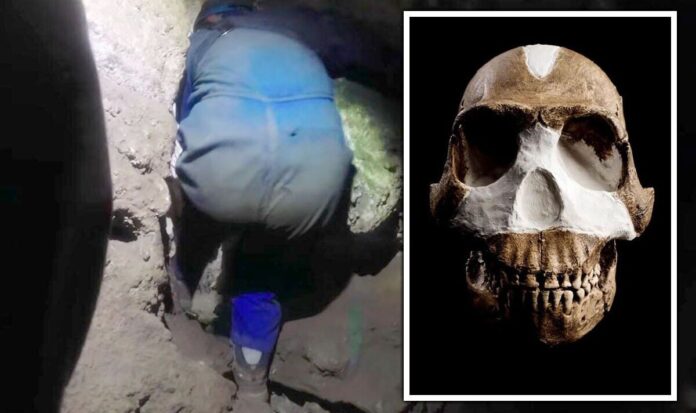Dr Lee Berger, a paleoanthropologist based in South Africa, had been exploring the Rising Star cave system for years. During his expeditions, he was made aware that there was at least one opening he had not yet ventured into. Locating the cave and heading inside, Dr Berger would return with evidence for an entirely new species of human.It soon proved to be the greatest single collection of fossilised skulls and bones ever found in Africa – the continent where the story of humans began.He and his team uncovered more than 1,550 fragments of some 15 skeletons belonging to a species that scientists identified as a member of the human family.Homo naledi joined the ranks of the others that make up the Homo genus, an ancestor explored during the Smithsonian Channel’s documentary, ‘The Life of Earth: The Age of Humans’.Speaking to the programme in 2015, he explained the simple yet effective process which led to his 2013 discovery: “I had this map I created of almost 800 cave sites that were all entryways into the underworld that I hadn’t been in yet – and that was the mission.” Cavers discovered the remains of many Homo naledi deep inside the Rising Star cave system (Image: Youtube/Smithsonian Channel) The Rising Star cave system is a part of the Cradle of Humankind heritage site (Image: Google Maps)Whispers of human remains existed among the locals, and when Dr Berger finally located the remains, he was “speechless”.He said: “There I saw something I thought I would never see in my entire career, there was a clearly primitive hominid just lying there on the surface in the dirt.”The remains he and his team found varied, from infants to elderly adults.Crucially, none belonged to any known human of the Homo genus.JUST IN: Earth’s ‘distress signal’ laid bare as dangerous heat levels broken Dr Lee Berger holds the skull of naledi (Image: GETTY)But what would Homo nadeli have looked like? From a distance, they would have looked just like us. But on closer inspection, key differences would quickly become clear.Their proportions were off: naledi was short with a small head and narrow shoulders, and pronounced ape-like facial features.Naledi would have once lived alongside Homo sapiens around 300,000 years ago, along with Homo Erectus and Homo neanderthalensis.The largest find of its kind ever made in Africa, countless mysteries surround naledi.DON’T MISSMetal detectorists’ possible treasures ‘worth thousands’ go missing [REPORT]UK firm to build new battery site to make electric vehicles cheaper [INSIGHT] Octopus Energy shares boiler hack saving customers £112 a year [ANALYSIS] Naledi laid out in its entirety (Image: Youtube/Smithsonian Channel) One theory suggests the cave acted as a burial site (Image: GETTY)How did the bones get into the caves? What sort of tools did it use? How did it survive alongside the larger-brained Homo genus’? Scientists will ultimately never know.But what they can be sure of is the fact that naledi rejects the narrative of linear human evolution that once prevailed in scientific circles.Dr Rick Potts, a paleoanthropologist at the National Museum of Natural History, also speaking during the documentary, said: “”We used to see human evolutionary history as that march of progress, from ape-like to human beings.”Instead, what we’ve learned is that there were contemporaries. Inside the cave system where naledi was found (Image: GETTY)”Our evolutionary tree is branching and diverse like the evolutionary trees of almost all other organisms on Earth.”So far, Homo naledi has only been found in South Africa’s Cradle of Humankind World Heritage Site, about 40 kilometres from Johannesburg.It could be that naledi evolved, lived, and died in this isolated region – many other Homo genus’ ended up stuck in a single area of the Earth.Homo floresiensis, for example, inhabited the island of Flores, Indonesia, and was as a result tiny, standing at 3 feet 7 inches, having adapted to its surroundings and needs. Berger holds a fragment of a naledi skull (Image: GETTY)In 2019, Homo naledia and Australopithecus sediba were put on public display for the first time in Dallas, Texas, at the Perot Museum.At the time, Professor Adam Habib, Vice-Chancellor and Principal of Wits University, said: “We are excited to share these South African national treasures, of which Wits University is the custodian, to audiences across the world.”Science should have no boundaries and our collective knowledge must be made available.”These fossils are evidence of our common origins and the research and knowledge thereof must transcend institutional, national and even disciplinary boundaries so that they mark a path to a collective future defined by human solidarity.”Our partnership with the Perot Museum is built in this spirit, and we look forward to enhancing it in the coming years.’
Caver recalls ‘speechless’ moment uncovering new species of human
Sourceexpress.co.uk
RELATED ARTICLES


